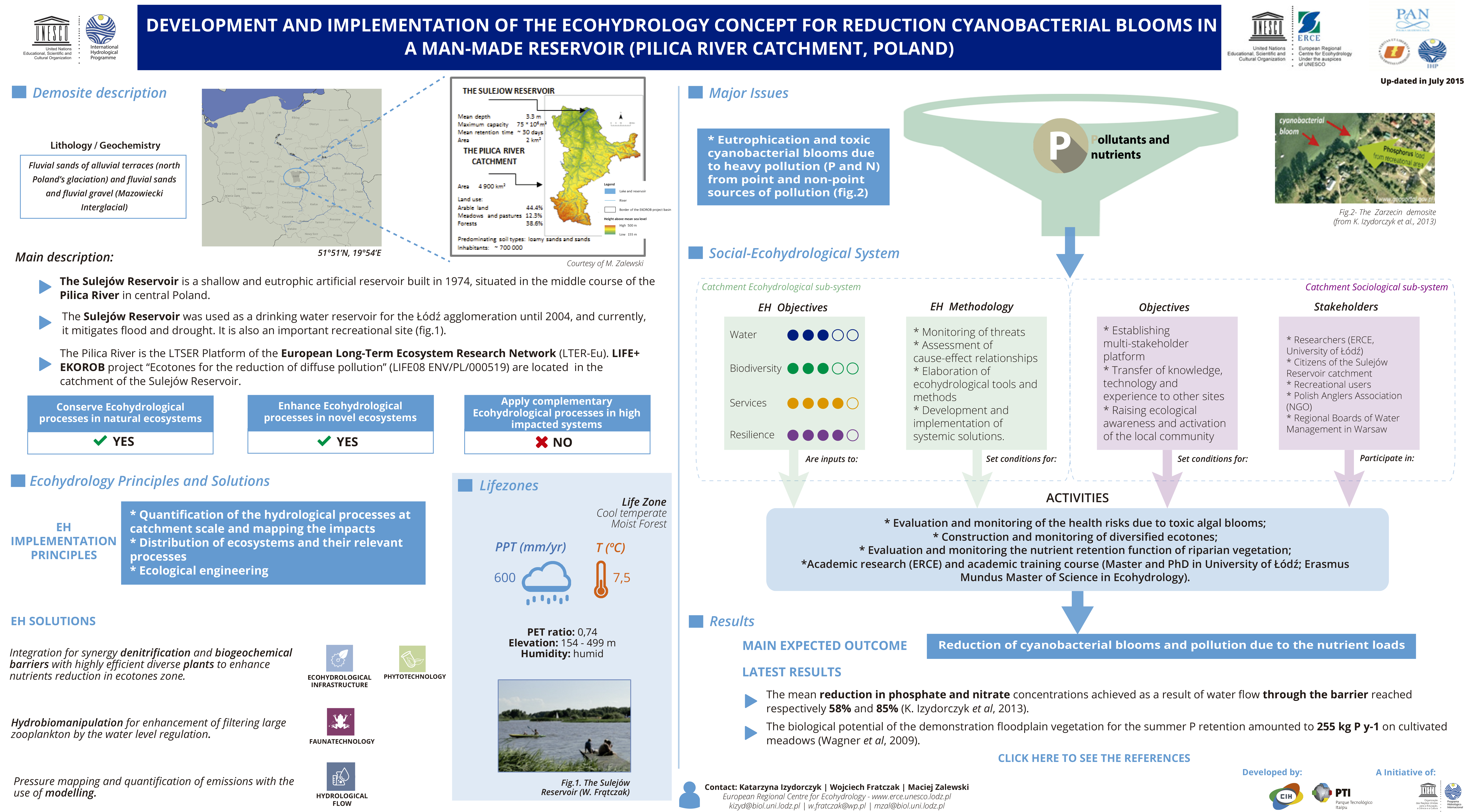DEVELOPMENT AND IMPLEMENTATION OF THE ECOHYDROLOGY CONCEPT FOR REDUCTION CYANOBACTERIAL BLOOMS IN A MAN-MADE RESERVOIR (PILICA RIVER CATCHMENT, POLAND)


Description
Location


Sketch

Information about lithology/geochemistry:
Fluvial sands of alluvial terraces (northPoland’s glaciation) and fluvial sands and fluvial gravel (Mazowiecki Interglacial).
Main Description
- The Sulejów Reservoir is a shallow and eutrophic artificial reservoir built in 1974, situated in the middle course of the Pilica River in central Poland.
- The Sulejów Reservoir was used as a drinking water reservoir for the Łódź agglomeration until 2004, and currently, it mitigates flood and drought. It is also an important recreational site (fig.1).
- The Pilica River is the LTSER Platform of the European Long-Term Ecosystem Research Network (LTER-Eu). LIFE+ EKOROB project ‘‘Ecotones for the reduction of diffuse pollution’’ (LIFE08 ENV/PL/000519) are located in the catchment of the Sulejow Reservoir.
Enhance ecohydrological processes in novel ecosystem
YES
Apply complementary Ecohydrological processes in high impacted system
NO
This table presents the different categories of ecosystem services that ecosystem can provide, divided in:
Provisioning Services are ecosystem services that describe the material or energy outputs from ecosystems. They include food, water and other resources.

Food: Ecosystems provide the conditions for growing food. Food comes principally from managed agro-ecosystems but marine and freshwater systems or forests also provide food for human consumption. Wild foods from forests are often underestimated.

Fresh water: Ecosystems play a vital role in the global hydrological cycle, as they regulate the flow and purification of water. Vegetation and forests influence the quantity of water available locally.
Regulating Services are the services that ecosystems provide by acting as regulators eg. regulating the quality of air and soil or by providing flood and disease control.

Moderation of extreme events: Extreme weather events or natural hazards include floods, storms, tsunamis, avalanches and landslides. Ecosystems and living organisms create buffers against natural disasters, thereby preventing possible damage. For example, wetlands can soak up flood water whilst trees can stabilize slopes. Coral reefs and mangroves help protect coastlines from storm damage.

Waste-water treatment: Ecosystems such as wetlands filter both human and animal waste and act as a natural buffer to the surrounding environment. Through the biological activity of microorganisms in the soil, most waste is broken down. Thereby pathogens (disease causing microbes) are eliminated, and the level of nutrients and pollution is reduced.
Ecosystem services "that are necessary for the production of all other ecosystem services". These include services such as nutrient recycling, primary production and soil formation.

Habitats for species: Habitats provide everything that an individual plant or animal needs to survive: food; water; and shelter. Each ecosystem provides different habitats that can be essential for a species’ lifecycle. Migratory species including birds, fish, mammals and insects all depend upon different ecosystems during their movements.
Cultural Services corresponds nonmaterial benefits people obtain from ecosystems through spiritual enrichment, cognitive development, reflection, recreation, and aesthetic experiences.

Recreation and mental and physical health: Walking and playing sports in green space is not only a good form of physical exercise but also lets people relax. The role that green space plays in maintaining mental and physical health is increasingly being recognized, despite difficulties of measurement.

Tourism: Ecosystems and biodiversity play an important role for many kinds of tourism which in turn provides considerable economic benefits and is a vital source of income for many countries. In 2008 global earnings from tourism summed up to US$ 944 billion. Cultural and eco-tourism can also educate people about the importance of biological diversity.
Lifezones

![]()
PPT(mm/yr): 600.0
![]()
T(ºc): 7.5
| Elevation of demosite: | 326.0 meters above sea level |
| Humidity: | Humid |
| PETr (by year): | 0.74 |
EH Principles
Quantification of the hydrological processes at catchment scale and mapping the impacts
Distribution of ecosystems and their relevant processes (ex: metabolism=water and nutrient uptake and retention; biomass production)
Ecological engineering (integration, dual regulation and biotechnologies in catchment scale for enhancement of ecological potential)
ECOHYDROLOGY ENGINEERING SOLUTIONS
Integration for synergy denitrification and biogeochemical barriers with highly efficient diverse plants to enhance nutrients reduction in ecotones zone.
 Ecohydrological Infrastructure
Ecohydrological Infrastructure
 Phytotechnology
Phytotechnology
Hydrobiomanipulation for enhancement of filtering large zooplankton by the water level regulation.
 Faunatechnology
Faunatechnology
Pressure mapping and quantification of emissions with the use of modelling.
 Hydrological Flow
Hydrological Flow
Major Issues
- Eutrophication and toxic cyanobacterial blooms due to heavy pollution (P and N) from point and non-point sources of pollution (fig.2).



Expected Outcomes
Reduction of cyanobacterial blooms and pollution due to the nutrient loads.
Latest Results
- The mean reduction in phosphate and nitrate concentrations achieved as a result of water flow through the barrier reached respectively 58% and 85% (K. Izydorczyk et al, 2013).
- The biological potential of the demonstration floodplain vegetation for the summer P retention amounted to 255 kg P y-1 on cultivated meadows (Wagner et al, 2009).
Contacts
Wojciech Fratczak
- w.fratczak@wp.pl
- www.erce.unesco.lodz.pl
- European Regional Centre for Ecohydrology
- www.erce.unesco.lodz.pl
Katarzyna Izydorczyk
- kizyd@biol.uni.lodz.pl
- www.erce.unesco.lodz.pl
- European Regional Centre for Ecohydrology
- www.erce.unesco.lodz.pl
Maciej Zalewski
- mzal@biol.uni.lodz.pl
- www.erce.unesco.lodz.pl
- European Regional Centre for Ecohydrology
- www.erce.unesco.lodz.pl

Social ecohydrological system
EH Objectives
EH Methodology
Catchment Ecohydrological sub-system
Objectives
Stakeholders
Catchment Sociological sub-system
Activities